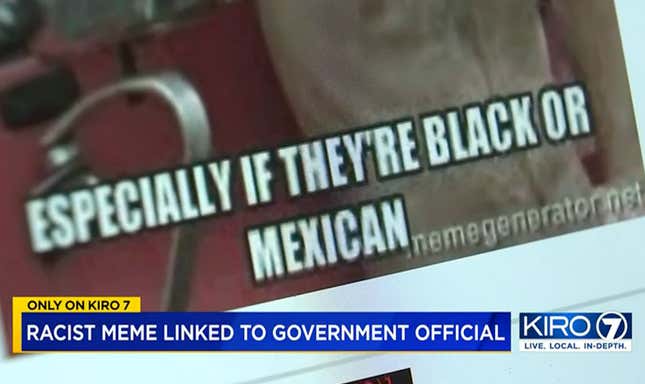
Patrick Reed, a public and government affairs manager for the secretary of Washington state, got caught sending a racist meme to a colleague making fun of Black and Mexican people, according to KIRO 7 Seattle. Residents of Sumner, where Reed is a council member, were disturbed by the image.
According to the news report, Reed’s colleague sent him a message a month ago celebrating that he’d been excused from jury duty. In response, according to the report, Reed attached an image of a shirtless white man with a mullet in front of a red pickup truck (this CAN’T be going anywhere good). The caption of the image read, “If they’re in court, they’re guilty…especially if they’re Black or Mexican.” Residents responded to the picture calling it “unprofessional” and “concerning” and one said he will reconsider voting for him again when he’s up for reelection.
Now, with the exception of one man of color, most of the reactions were from white people. But us? Black people expect nothing less than a government official being exposed for being racist. However, if it’s true this one state official holds these kind of beliefs about Black people, imagine what some court officials are thinking when a person of color enters the courtroom.
Look at Prison Policy’s report on Washington’s incarceration rates:
Washington State has an incarceration rate of 455 per 100,000 people (including prisons, jails, immigration detention, and juvenile justice facilities), meaning that it locks up a higher percentage of its people than almost any democracy on earth.
Additionally, the number of people impacted by county and city jails in Washington is much larger than the graph above would suggest, because people cycle through local jails relatively quickly. Each year, at least 98,000 different people are booked into local jails in Washington.
As of December 2020, Washington prisons were still over 95% capacity. Washington failed to utilize one of the most obvious, and easiest, tools for reducing the prison population — stopping prison admissions for technical violations of probation and parole (which are not crimes).
As one could assume, the state’s prison population is overrepresented by people of color. In 2010, there were 2,000 more Black people in prison than white or Hispanic people, per Prison Policy. The report also found that as white incarceration rates went down Black incarceration rates increased.
It’s not neuroscience. When people believe Black or Hispanic people are more prone to being criminal, that’s exactly what leads to them being convicted at a higher rate, given exaggerated sentences and denied their ability to defend themselves.

